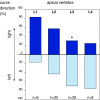Spinal decompensation in degenerative lumbar scoliosis
- PMID: 20300782
- PMCID: PMC2989284
- DOI: 10.1007/s00586-010-1368-z
Spinal decompensation in degenerative lumbar scoliosis
Abstract
Due to the aging population, degenerative scoliosis is a growing clinical problem. It is associated with back pain and radicular symptoms. The pathogenesis of degenerative scoliosis lies in degenerative changes of the spinal structures, such as the intervertebral disc, the facet joints and the vertebrae itself. Possibly muscle weakness also plays a role. However, it is not clear what exactly causes the decompensation to occur and what determines the direction of the curve. It is known that in the normal spine a pre-existing rotation exists at the thoracic level, but not at the lumbar level. In this retrospective study we have investigated if a predominant curve pattern can be found in degenerative scoliosis and whether symptoms are predominantly present at one side relative to the curve direction. The lumbar curves of 88 patients with degenerative scoliosis were analyzed and symptoms were recorded. It was found that curve direction depended significantly on the apical level of the curve. The majority of curves with an apex above L2 were convex to the right, whereas curves with an apex below L2 were more frequently convex to the left. This would indicate that also in degenerative scoliosis the innate curvature and rotational pattern of the spine plays a role in the direction of the curve. Unilateral symptoms were not coupled to the curve direction. It is believed that the symptoms are related to local and more specific degenerative changes besides the scoliotic curve itself.
Figures

References
MeSH terms
LinkOut - more resources
Full Text Sources
Medical
Miscellaneous

